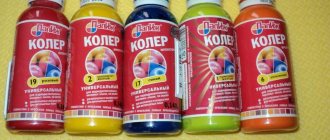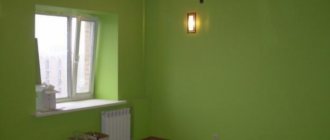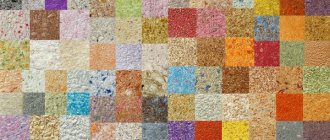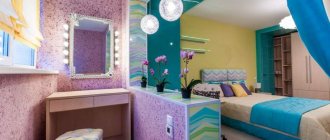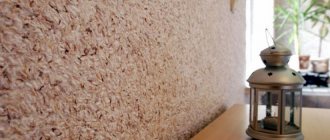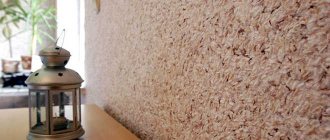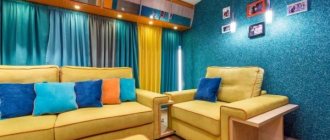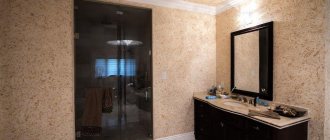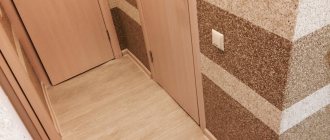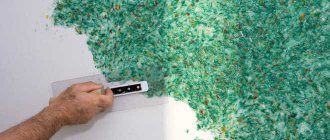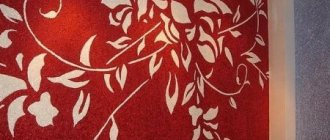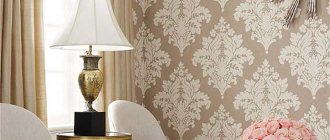0
14.12.2021
During renovations, the problem often arises of which color for liquid wallpaper is best to choose. Before purchasing, you need to study the features of color solutions, rules for choosing shades and standards for applying the material.
Options for tinting pastes
Basic Concepts
Page navigation
Liquid wallpaper refers to a finishing method that can be used on any surface. They contain cellulose, CMC, synthetic or natural fibers:
- organic compounds have a rich color palette, but it is exposed to external influences and fades faster;
- artificial ones have a modest selection of shades, but they are resistant to ultraviolet radiation.
The advantages of liquid wallpaper include the ability to choose your own color. Giving the mixture the desired tone is called tinting.
Ready solutions from the manufacturer
How to find out if you can add color to liquid wallpaper
On construction forums, visitors ask whether it is possible to add color to ordinary liquid wallpaper. For this material, it is possible to choose any color scheme with the required level of saturation and shade.
What types of liquid wallpaper can be tinted
The best choice is white or colorless bases. When using them, it is easy to obtain the expected color shade. The tinting will be more accurate than when selecting a tone for a colored mixture.
Do not pour dry pigment into a wallpaper base previously diluted with water. With this approach it is impossible to achieve uniform distribution of the powder. There is a risk of clumps appearing during dilution or stains after painting is completed.
Light varieties
Pros and cons of painting
Painting liquid wallpaper on a wall is a cosmetic renovation option that is not without its advantages:
- the ability to quickly transform the design of a room in a simple and labor-intensive way;
- no need to remove the old coating;
- the surface becomes washable;
- Without large financial investments, it is possible to update dirty, faded or tired finishes.
Restoring and painting liquid wallpaper will save your budget and transform the room. Although manufacturers do not particularly recommend doing this, silk plaster tolerates staining normally, although it does not become quite silky. After painting it will lose its original properties:
- The surface will become cold and hard, and the feeling of soft velvety will disappear.
- Decorative inclusions will not become visible after painting, the effect of silkiness and warm, voluminous texture will disappear.
- Vapor permeability will be lost under the paintwork.
- Local repairs to damaged areas will become impossible, as the wallpaper will no longer soak in water.
- After painting, liquid wallpaper will not be easy to remove from the wall and cannot be reused.
These disadvantages can be avoided if you paint the wallpaper after first removing it from the wall. Color and decorative elements are added to the soaked mass. After this, the updated wallpaper is applied to the wall again. This method is more energy-consuming and messy; you may have to buy several bags of wallpaper flakes. But the result is worth it - silk plaster will retain all its positive qualities, and the transformed walls will continue to breathe, as before, maintaining a healthy microclimate in the room.
How to do it:
- Mix water with the chosen pigment.
- Add and mix glitter or other decorative elements.
- Add wallpaper mixture.
- Mix everything carefully with your hands, trying not to damage the structure of the material.
Next, the wallpaper paste is applied to the wall with a plastic trowel.
How to choose a color for liquid wallpaper
The color scheme for the base is selected according to several criteria. These include the brand and manufacturer, interior design, etc.
Criterias of choice
When choosing a suitable tone, rely on the following characteristics:
- it should be in harmony with the furniture and other objects in the room;
- It is advisable to take formulations of the same brand;
- Before purchasing, the characteristics and reviews of the brand are carefully studied - preference is given to companies associated with the finishing materials market for at least 7-10 years.
When purchasing, be sure to check the expiration date of coloring pigments.
In the interior
Popular brands of colors and prices
There are coloring solutions and pastes on the market from foreign and domestic manufacturers. Local goods are not always worse than foreign ones; they are often cheaper.
Comparison table of popular materials:
| Name | A country | Color features | Volume in liters | Cost in rubles |
| Dufa | Germany | based on synthetic resins | 0,75 | 360 |
| Tex | RF | colored varnish for plaster, putty, water-based paint | 0,75 | 186 |
| Profilux | RF | universal dye for interior and exterior decoration | 0,45 | 148 |
| Alpina | Germany | for hand dyeing | 0,5 | 360 |
| Cover Color | RF | highly concentrated acrylate based paint | 0,75 | 125 |
| Acomix by Dulux | Great Britain | elite class | 1 | 1000 |
Expert opinion
Experts advise:
- you cannot add dye to pre-mixed material - there is a risk of getting uneven coloring, lumps in the main composition, which will ruin the whole work;
- Do not mix pigments from different manufacturers - the chemical components may react;
- Before starting work, you should mix a small amount of colorless base and dye, check the correctness of the chosen tone and saturation in the room itself.
The ideal solution would be to purchase liquid wallpaper and colors from the same brand. Not all manufacturers produce these products, so you can choose a suitable composition based on price and shade. Be sure to look at the expiration dates.
Types of paints
There are two ways to paint liquid wallpaper:
- Remove the material from the wall, soak it, tint it, then apply it again.
- Conventional surface painting, i.e. applying a layer of paint.
Pay attention to: Painting the garage floor
Now let’s look at what to paint on the surface. Any water-based paint is suitable for liquid wallpaper.
Water-based emulsions
The most affordable is water-based emulsion, which is usually used to whiten ceilings. Due to different degrees of dilution, shades of varying intensity can be obtained. Water-based emulsions are easily tinted to any color palette.
Acrylic
Acrylic compositions are more resistant to mechanical damage compared to water-based ones. The elastic film extends the service life of the easily abraded fiber coating by up to 20 years. Also, water-dispersed acrylic films are washed, unlike water-based emulsions, and with the use of chemicals.
Latex
Latex paints adhere perfectly and are also highly water-repellent, so walls can be easily washed off from dirt. They are characterized by high mechanical strength, low consumption, and environmental safety. They are intended for children's rooms, kitchens, bathrooms - i.e. for the most problematic rooms. However, they require good ventilation and even temperatures, otherwise they will quickly become overgrown with mold. In the cold, as well as during sudden temperature changes, latex films crack. And liquid wallpaper is not even intended for painting for damp rooms, so latex is applied mainly locally.
Silicone
Silicone compounds are also suitable for creating washable surfaces, but their high cost does not suit everyone. Although silicone paint for liquid wallpaper is the best option, because the films created are “breathable”. Their service life is more than 25 years. The absence of surface tension prevents the film from cracking during sudden temperature changes. Silicone paints do not fade in the sun, and their thick consistency allows you to hide surface imperfections, even sealing cracks several mm deep.
Pay attention to: Painting OSB boards indoors: choosing the right paint, preparation and painting process
Lucky
In some cases, transparent furniture varnish is used instead of paint. This is justified for creating small washable areas, for example around switches.
Water-based paint
Acrylic paint
Latex paint
Silicone paint
Furniture varnish
How to apply color
To combine the base base with the dye, follow these steps:
- the pigment concentrate is dissolved in water - according to the instructions;
- the base is added to the prepared solution;
- the mixture is mixed manually to prevent accidental damage to the material - until it is homogeneous.
If necessary, various decorative elements or sparkles are additionally added to the composition.
Tinting process
Painting stages
The work is carried out according to the algorithm:
- The surface is pre-treated to remove accumulated dust and contaminants.
- Oil stains are degreased.
- Cleaning is done with the utmost care, without damaging the top layer.
- A deep penetration primer is applied to the surface.
- The last step is to apply the prepared liquid wallpaper using a trowel.
It is necessary to create a uniform layer of coating - this way it will dry faster.
Experiment with color during application
Checking the correctness of the selected color scheme is carried out on a small section of the wall or a sheet of paper. This approach will allow you to see the results after drying, add the required amount of dye if the shades are too pale or dull.
To obtain a richly colored mixture, it is better to initially introduce more coloring pigment into the base. It will be impossible to change the results later, even if they do not suit the color scheme.
After breaking the mixing rule
Painting with drawing
The paint can be applied not in a continuous layer, but to create textured surfaces and patterns. To do this, during the first painting with a roller, they achieve an even background, and the next layer is applied by trimming or drawing stains without pressing too hard on the tool.
Various patterns and designs can also be applied using a special stencil. You can buy it or make it yourself from a large sheet of thick cardboard. The desired design is applied to the cardboard and cut out with a sharp knife. The resulting stencil is applied to a section of the wall and passed over it with a roller dipped in paint. At the same time, the roller should not be overloaded with paint, otherwise it will begin to leak under the stencil.
Craftsmen advise using partial painting if decorative painting is required. This is a complex process that will require skill and someone's help.
Is it possible to store tinted liquid wallpaper?
After adding the color to the main mixture, storage cannot last more than 3 hours. After the end of the period, the tone begins to change, the adhesive properties decrease, which leads to a deterioration in the ability of the coating to adhere to the painted surfaces.
After preparing the liquid wallpaper and adding color, they must be covered with a lid - contact of the mixture with air should be minimal.
The limited shelf life of the finished material requires its preparation on site, at home. The existing computer service for creating an accurate color scheme is relevant in cases where delivery of the mixture to the customer takes minimal time.
In order not to face the question of how to tint and what the result will look like, just use the instructions for applying and mixing additives with the base base. You need to spread them with your hands to obtain a homogeneous, intact mixture.
